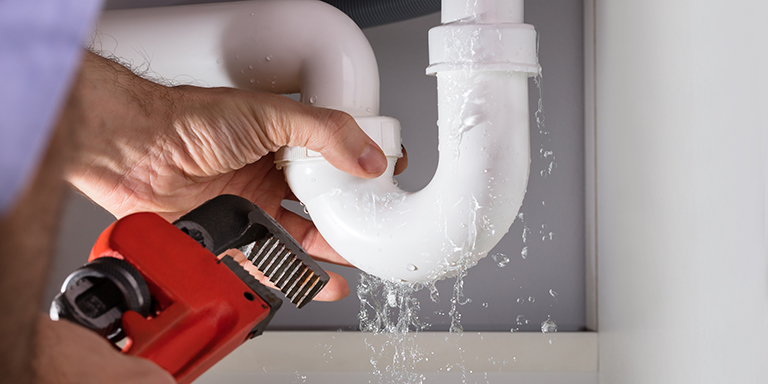When the alarm goes off in the middle of the night, there are a few things it could be. But if it sounds like the drip-drip-drip of a faucet, urgency kicks in. Home emergencies are practically unavoidable, and when it comes to plumbing, they can range from a minor inconvenience to a major disaster. However, a surprising number of these crises can be handled—or at least mitigated—until the cavalry (or in this case, the plumber) arrives. This blog post is dedicated to those who find themselves suddenly facing an aquatic calamity, and serve as a handy guide to help you handle the most common plumbing problems before they cause irreparable damage to your home.
Common Household Plumbing Emergencies
Water damage is the unwelcome guest that sneaks into our homes by way of pipe leaks, faucet overflows, or appliance malfunctions. These emergencies can include:
- Burst pipes: This sudden pipe failure can occur due to freezing temperatures or water pressure spikes, often resulting in a considerable amount of water flooding the area.
- Toilet overflows: Whether it’s a clogged drain or faulty valve, an overflowing toilet can lead to unsanitary conditions and significant water damage.
- Leaky faucets or fixtures: While this might not seem as urgent, even a small leak can waste gallons of water and signal a larger issue.
- Sewage backups: A telltale sign of a clog in the main sewer line, sewage backups can pose serious health risks and require immediate attention.
- Hot water heater leaks: These can flood your utility area and, if left unaddressed, can also create safety hazards.
In the following sections, we will provide detailed steps on how to handle these situations promptly and safely.
Emergency Plumbing Hacks
Burst Pipes
A burst pipe is a moment of pure panic, but control is key. Here’s how to minimize the damage:
Step 1: Shut Off the Water
Locate your main water valve and turn it off. This will stop the flow of water and prevent further damage.
Step 2: Drain the Water
After turning off the main valve, open all the taps to drain the remaining water from the system. Start from the highest point and work your way down.
Step 3: Inspect the Damage
Assess the extent of the burst and start managing the water. If it’s a small rupture, you can apply a pipe repair clamp after the area is completely dry.
Step 4: Temporarily Seal
Use repair tape or a wrap-around pipe patch as a temporary fix until a professional can replace the damaged section.
Toilet Overflows
Act quickly to avoid contamination and further spillage.
Step 1: Turn Off the Water Supply
Locate the shut-off valve behind or near the toilet and turn it clockwise to stop the water.
Step 2: Remove Excess Water
Use a plunger or a bucket to remove the excess water from the bowl. Be sure to wear rubber gloves for sanitary reasons.
Step 3: Address the Clog
Use a plumbing snake or a closet auger to dislodge the obstruction. In a pinch, a wire hanger can sometimes do the trick.
Step 4: Turn the Water On Slowly
Once the clog is cleared and the bowl is empty, turn the water back on gradually to fill the bowl and make sure it drains properly.
Leaky Faucets or Fixtures
A leaky faucet might not seem urgent, but it can waste a surprising amount of water.
Step 1: Shut Off the Water
Similar to a burst pipe, locate the shut-off valves that control the water flow to the fixture and turn those off.
Step 2: Diagnose the Leak
Identify the cause of the leak. In many cases, it’s a worn-out washer or O-ring that needs replacing.
Step 3: Gather Your Tools
You’ll need a wrench, a screwdriver, and a plumbing repair kit.
Step 4: Replace the Faulty Part
Carefully disassemble the fixture and replace the damaged parts with new ones from the repair kit. Reassemble the fixture and test for leaks.
Sewage Backups
This is one situation where avoiding direct contact with the water is vital.
Step 1: Stop Using All Water
To prevent an overflow, don’t use any water. This includes flushing the toilet or running taps.
Step 2: Ventilate the Area
Open windows and doors to allow any gas to dissipate.
Step 3: Remove Water
Use a wet-dry vacuum to remove standing water from the affected area. Dispose of the water safely and sanitize the vac afterward.
Step 4: Call a Professional
This isn’t a problem you can handle on your own. Call a plumber like Bodenheimer Plumbing to assess the situation and take appropriate action.
Hot Water Heater Leaks
A leaking water heater is a serious problem. Here’s how to deal with it safely.
Step 1: Turn Off the Power
If you have an electric heater, turn off the power at the breaker box. For gas heaters, set the gas control valve to “pilot” to shut off the gas supply.
Step 2: Shut Off the Water Supply
Locate the cold water inlet valve and turn it off to prevent more water from entering the tank.
Step 3: Drain the Tank
Connect a garden hose to the drain valve and empty the tank into a floor drain or outside.
Step 4: Repair or Replace
Depending on the severity of the leak, you may be able to repair the tank. In most cases, though, a replacement is necessary.
When to Call a Professional
While the information shared in the hacks above can be valuable in the short term, there are certain situations where you should immediately seek the help of a professional plumber. These include:
- If you’re unable to locate or turn off the water main valve.
- If the damage is extensive or located in hard-to-reach areas.
- If the issue involves the main sewer line or the water heater.
Remember, your safety and the structural integrity of your property are not worth the risk of attempting repairs beyond your expertise.
Preventing Future Emergencies
An ounce of prevention is worth a pound of cure, and that’s particularly true when it comes to plumbing.
- Regular Maintenance: Schedule yearly inspections with a professional to catch potential issues before they become emergencies.
- Know Your System: Familiarize yourself with the location of shut-off valves and understand how to operate them.
- Protect Your Pipes: Use insulation on pipes in cold areas of your home to prevent freezing.
- Be Careful What You Flush: Only flush waste and toilet paper down the toilet. Everything else can cause clogs.
Bodenheimer Plumbing Services: Quick and Reliable Solutions
Plumbing emergencies have a way of overwhelming homeowners, but that doesn’t mean you’re powerless to protect your property. By following the steps outlined above, you can mitigate damage and ensure the safety of your home until professional help arrives. Remember, in the case of a serious issue, it’s always best to call in the experts. However, having this knowledge in your back pocket can make all the difference in an emergency.
Contact Bodenheimer Plumbing Services for all your plumbing needs. Our team of skilled professionals is available 24/7 to handle any emergency that arises, and we offer a range of services to keep your plumbing in top condition. Don’t let a small leak turn into a costly disaster – trust our experts to provide quick and reliable solutions. So, always be prepared for emergencies and take preventative measures to avoid them in the future. With these tips and the help of Bodenheimer Plumbing Services, you can rest easy knowing that your plumbing is in good hands.
Disclaimer: The information provided in this document is for general knowledge purposes only and should not be used as a substitute for professional advice. Always seek the guidance of a licensed plumber for any plumbing emergencies or repairs.
Vote for Bodenheimer Plumbing Services in the 2024 Readers Choice Awards
Bodenheimer Plumbing is a finalist in the 2024 Readers Choice Awards in the Plumber (Business) category. If you are satisfied with our services, please consider casting your vote for us in the voting period from April 9 – April 30. Your support means a lot to us and helps us continue providing top-quality plumbing solutions to businesses like yours!


